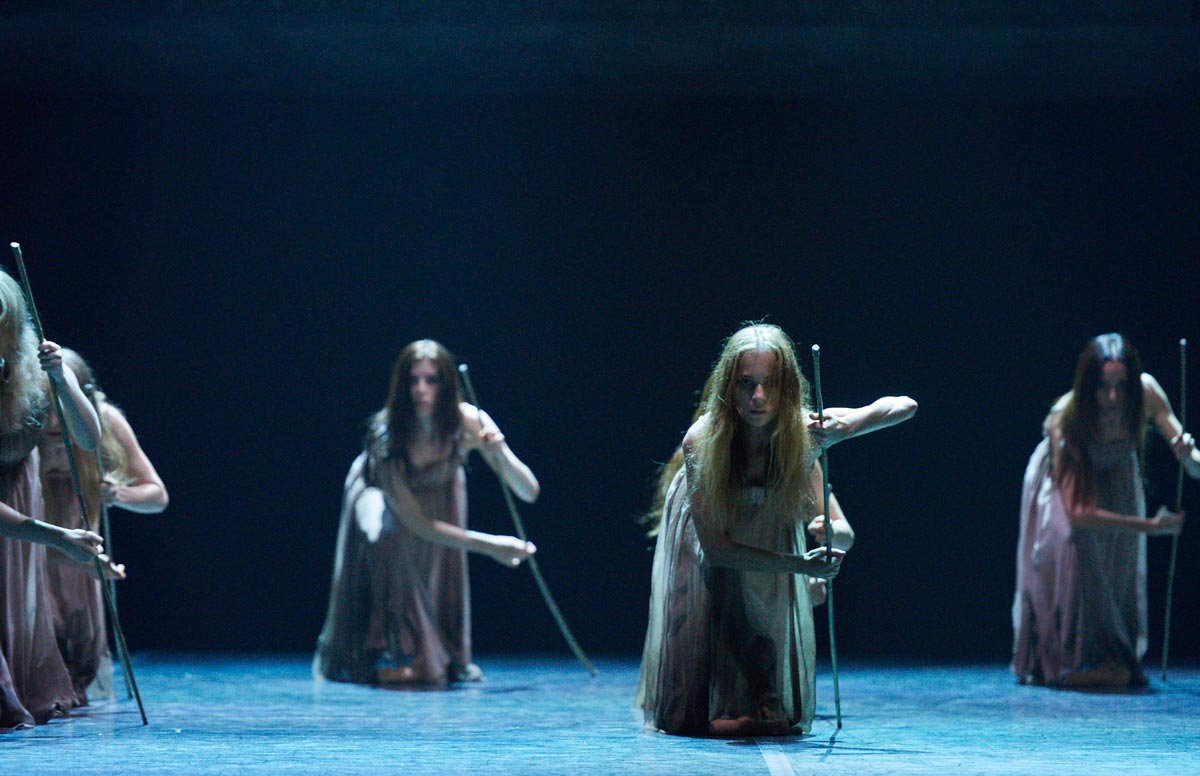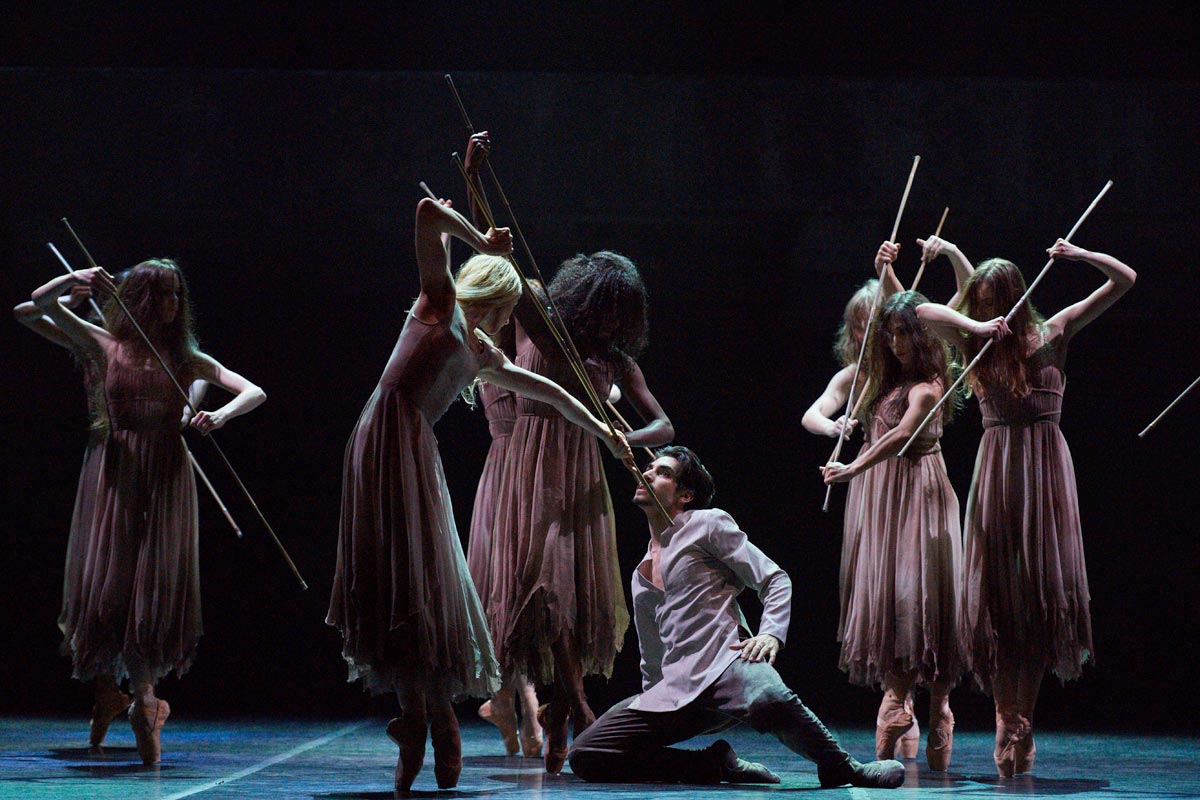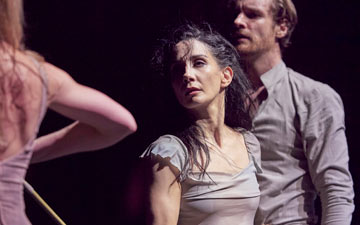
© Laurent Liotardo. (Click image for larger version)
English National Ballet
Giselle
★★★★✰
London, Sadler’s Wells
15 November 2016
www.ballet.org.uk
www.sadlerswells.com
Akram Khan’s reimagining of Giselle has been one of the most anticipated dance events of the year. The possibilities created by a fusion of the kathak/contemporary choreographer’s emotive force and classical ballet’s structure were tested (very successfully) in Dust, English National Ballet’s first collaboration with Khan. Giselle is a full-length exploration – and a mark of the bold experimental vision that the ENB artistic director Tamara Rojo has for her company.
Much that is familiar about Giselle has been swept away in Khan’s reboot, including the Mittel-European setting and most of Adolphe Adam’s score (replaced with an electro-orchestral soundscape by Vincenzo Lamagna that gets a bit stuck in a rut in places). Giselle was a weak-hearted girl at the centre of life in a peasant village – now she is one of a desperate throng of migrant garment factory workers, the collateral damage of free market capitalism, shut off from work, and hope, by the set designer Tim Yip’s mighty, handprint-spattered wall. But Khan keeps glimmers of the original – for instance, the outcasts move into mass routines with strong folk dance echoes before forming lines and adopting the physical language of industrial toil.

© Laurent Liotardo. (Click image for larger version)
Among them darts Cesar Corrales’s savagely charismatic Hilarion, moving with angular, lizard-like swiftness and guile. He’s now a “fixer”, according to the programme, trading with the rich landlord class. He’s besotted with Giselle, but she’s transfixed (and pregnant?) by Albrecht, who unknown to her is one of the landlords disguised as a fellow outcast. Danced here by Rojo and James Streeter, in their touching first duet Giselle seems light as air and enchantingly swept off her feet.
But here’s the main problem with this production – you’d struggle to work out much of this storyline from what’s offered on stage – it’s as if an unfair assumption has been made that audiences will be familiar with the original Giselle and can map the narrative on to the piece for themselves. Khan’s focus is on striking visuals, whether in mass movement or individual intricacy – and here the work gives in abundance, particularly when the wall swings up and the landlords arrive in a blast of sirens (a modern take on the hunting bugle call), dressed in staggeringly ostentatious couture, like a Velasquez painting come terrifyingly to life.

© Laurent Liotardo. (Click image for larger version)
The outcasts are made to show their obeisance; Khan’s choreography makes thrilling use of unusual hand and arm gestures, and sends shockwaves through some dancers with moves akin to b-boy locking. Rojo’s Giselle, far from being weak-hearted, is gloriously defiant, repeating a challenging “brush it off your shoulder” gesture even as she seems to fall in line, and using Khan’s kathak spins almost as a weapon.
But the outing of Albrecht is muddled because Begona Cao’s marvellously icy Bathilde spotting him in the throng is the first clear staged indication he’s maybe not who we thought. And the climax of the scene – Giselle’s death – is deliberately obscured. It’s setting up a “reveal” in Act II – where the events are played out again in full view and we see why Hilarion is a worthy victim of the Wilis’ wrath. But it’s an unsatisfying way to end the first part.

© Laurent Liotardo. (Click image for larger version)
And so to those Wilis, here female co-workers killed by brutal labour conditions, haunting a “ghost factory” (which doesn’t look substantially different from where we were in Act I). Stina Quagebeur’s marvellously dominating Wili Queen reanimates Giselle with brutal insistence; her ghost army, lank-haired and brandishing bamboo poles, swarm on stage on pointe and pretty much stay up on their toes, gliding around with pas de bourree even as they have to struggle and jerk their bodies.
Hilarion meets his end horrifyingly – there’s almost a J-horror aesthetic to the way he’s stalked, surrounded and pinned like an insect. In fact, it takes some of the shine away from Giselle and Albrecht’s final pas de deux, where she shimmers achingly between life and death. Unfortunately, we’ve been given so little idea of Albrecht that Streeter understandably struggles to imbue him with much character, so you can’t help but wonder why Rojo’s Giselle still looks so tenderly on a man who left her sprawled on the ground and walked off with his fiancée. Still, there are beautiful dance moments here, and more classic Khan touches, such as the pair entwined, Rojo with her legs round Streeter’s middle, arching away from each other in echoes of Sacred Monsters.

© Laurent Liotardo. (Click image for larger version)
Khan’s revision of this classic ballet is spirited and confident; its faults are definitely fixable. This is bravura dance-making and a thrilling addition to the ENB’s repertoire.

















I saw Giselle performed by Alina Cojocaru this week and a splendid job ENB and the team made of it. More than a touch of “1984”, Kubrik’s 2001 and Ligeti about the set and music which was effective. A fundamental flaw in Khan’s story, however, is describing the exploiters of migrant workers as landlords instead of capitalists. It’s possible to argue such people exploit all workers not just migrant workers. Maybe people traffickers would be a more appropriate reference? A simple change in the programme would do it.